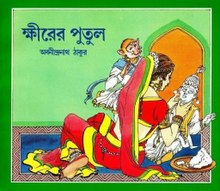Khirer Putul
 Queen and monkey | |
| Author | Abanindranath Tagore |
|---|---|
| Language | Bengali |
| Subject | Children's Literature |
| Published | 1896 |
| Publication place | India |
Khirer Putul (lit. 'Doll of
It was also adapted into a play by the Indian theatre group Nandikar in 2017, with Anindita Chakraborty as its director.[9]
Plot
The king of Deepnagar had two queens, Suo Rani and Duo Rani. The king gave Suo Rani 7 palaces, 700 female slaves, best ornaments from 7 kingdoms, 7 gardens, 7 chariots. He neglected Duo Rani and gave her a broken home, a deaf and dumb maid, torn clothes and a dirty bed.[10][11]

Translations
The work has been translated into several languages:
- French – La poupée de fromage.[12]
- Swedish – Ostdockan.[13][14]
- English – The Make-Believe Prince;[15] Caramel Doll.[16]
Development
Abanindranath who was Rabindranath Tagore's nephew found this story in Rabindranath's wife Mrinalini Devi's diary after her death. The novel is based on the story written in her diary.[17] The illustrations were done by Abanindranath Tagore.[18][page needed]
Analysis
According to scholar Sanjay Sircar, the tale can be classified in the
References
- ^ Children's literature of Bengal. Academy for Documentation & Research on Children's Literature, 1978. 1978.
- ISBN 9788177564990.
- ^ The Modern Review, Volumes 91-92. Prabasi Press Private, Limited. 1952.
- ISBN 9788192979809.
- ^ Tagore, Abanindranath. "Khirer Putul". The Pitara. Archived from the original on 26 April 2020. Retrieved 4 February 2019.
- ^ ঠাকুর, অবনীন্দ্রনাথ (August 2014). ক্ষীরের পুতুল / Khirer Putul (Bengali): Bengali Children's classic storie. editionNEXT.com.
- ^ Indian Cinema. Directorate of Film Festivals, Ministry of Information and Broadcasting. 1979. p. 66.
- ^ "Khirer Putul". ZEE5.
- ^ "National Theatre Festival 2017". nandikar.net. 16 December 2017.
- ^ Bardhan, Kalpana, ed. (2010). The Oxford India anthology of Bengali literature. Vol. 1: 1861-1941. New Delhi: Oxford University Press. pp. 129–150.
- ^ Mitra, Bansari (2002). The Renovation of Folk Tales by Five Modern Bengali writers. Anthropological Survey of India. p. 38.
- ^ La Poupée de fromage ("Khirère poutoul"). Préface de Selma Lagerlöf. Bois dessinés et gravés par Andrée Karpelès. Éditions Ophrys. 1950.
- ^ Ostdockan: en bengalisk saga. K[oop.] F[örb.]:s Bokförl. 1949.
- ^ "OSTDOCKAN: EN BENGALISK SAGA". biblio.com/.
- ^ Sircar, Sanjay. Fantasy Fictions from the Bengal Renaissance: Abanindranath Tagore, ‘The Make-Believe Prince’ – Gaganendranath Tagore, ‘Toddy-Cat the Bold’. New Delhi: Oxford University Press, 2018.
- ^ Bardhan, Kalpana, ed. (2010). The Oxford India anthology of Bengali literature. Vol. 1: 1861-1941. New Delhi: Oxford University Press. pp. 129–150.
- ISBN 9788184759914.
- ISBN 9788129127501.
- ^ Zipes, Jack (2020). "Fantasy Fictions from the Bengal Renaissance ed. by Sanjay Sircar (review)". Marvels & Tales. 34 (1): 121–122. Project MUSE 766045.
- ^ Aarne, Antti; Thompson, Stith. The types of the folktale: a classification and bibliography. Folklore Fellows Communications FFC no. 184. Helsinki: Academia Scientiarum Fennica, 1961. pp. 155-156.
- S2CID 234091187.
- ^ Marzolph, Ulrich. Typologie des persischen Volksmärchens. Beirut: Orient-Inst. der Deutschen Morgenländischen Ges.; Wiesbaden: Steiner [in Komm.], 1984. pp. 93-94.
Further reading
- Sircar, Sanjay (1995). "A MÄRCHEN AND A KUNSTMÄRCHEN FROM BENGAL: 'PRINCESS KALAVATI' AND ABANINDRANATH TAGORE'S THE CONDENSED-MILK DOLL (1896)". Journal of South Asian Literature. 30 (1/2): 212–52. JSTOR 40873586. Accessed 10 Nov. 2023.
- Sircar, Sanjay (1998). "Shashthi's Land: Folk Nursery Rhyme in Abanindranath Tagore's 'The Condensed-Milk Doll'". doi:10.2307/1178995. Accessed 10 Nov. 2023.
External links
- Illustration By Ashish Sengupta
- "Khirer Putul". gaana.com. Gaana. Archived from the original on 10 May 2020. Retrieved 23 June 2015.
